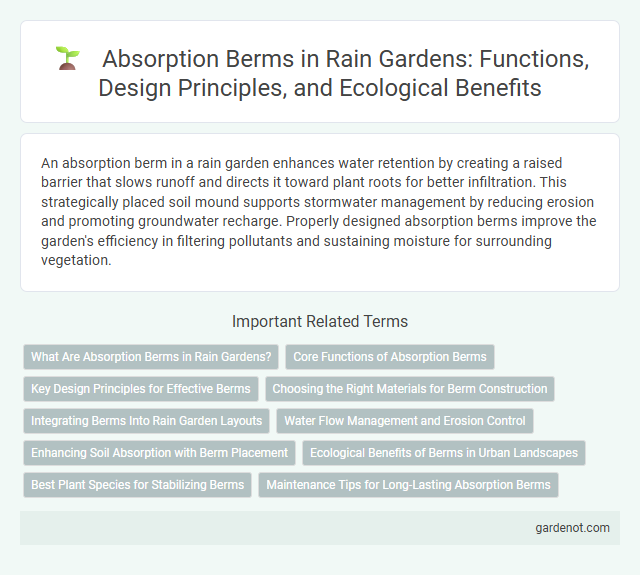An absorption berm in a rain garden enhances water retention by creating a raised barrier that slows runoff and directs it toward plant roots for better infiltration. This strategically placed soil mound supports stormwater management by reducing erosion and promoting groundwater recharge. Properly designed absorption berms improve the garden's efficiency in filtering pollutants and sustaining moisture for surrounding vegetation.
What Are Absorption Berms in Rain Gardens?
Absorption berms in rain gardens are raised soil barriers designed to slow down and direct stormwater runoff, enhancing water infiltration into the soil. These berms help retain water within the garden, reducing surface runoff and promoting groundwater recharge. Constructed from compacted soil or mulch, absorption berms improve the rain garden's ability to manage and filter rainwater effectively.
Core Functions of Absorption Berms
Absorption berms play a critical role in managing stormwater by capturing and slowing runoff, allowing enhanced infiltration into the soil. These structures help filter pollutants from surface water, reducing contamination before it reaches groundwater or nearby water bodies. By directing water flow and promoting absorption, absorption berms contribute significantly to erosion control and improved watershed health.
Key Design Principles for Effective Berms
An absorption berm in a rain garden should be strategically designed with a gentle slope of 2% to 5% to facilitate optimal water infiltration and prevent erosion. Selecting native, deep-rooted vegetation enhances soil stability and maximizes pollutant uptake, while incorporating porous materials ensures efficient water retention and gradual release. Proper berm height and placement, typically 6 to 12 inches tall on the downhill side, are crucial for directing runoff flow and preventing overflow during heavy rainfall events.
Choosing the Right Materials for Berm Construction
Choosing the right materials for absorption berm construction is crucial to maximize water retention and filtration in a rain garden. Permeable soils, such as sandy loam or amended native soils, enhance infiltration rates while preventing waterlogging and erosion. Incorporating organic matter like compost improves soil structure and nutrient absorption, supporting vegetation growth and long-term berm stability.
Integrating Berms Into Rain Garden Layouts
Absorption berms enhance rain garden effectiveness by directing and slowing stormwater flow, promoting infiltration and reducing runoff. Strategically placing berms along the garden's perimeter or at key points ensures optimal water distribution, supporting native plant growth and minimizing erosion. Incorporating varying heights and permeable materials in berm construction further maximizes water retention and soil absorption capacity.
Water Flow Management and Erosion Control
An absorption berm strategically redirects water flow to maximize infiltration and minimize runoff, effectively reducing erosion in rain garden landscapes. Constructed with soil and vegetation, the berm slows water velocity, promoting sediment deposition and preventing soil displacement. This natural barrier enhances water retention while supporting sustainable stormwater management and erosion control in urban environments.
Enhancing Soil Absorption with Berm Placement
Absorption berms strategically placed around rain gardens significantly improve soil infiltration by directing runoff into planted areas, increasing water retention and reducing surface erosion. These berms, typically constructed from compacted soil or mulch, create a natural barrier that slows water flow, allowing more time for soil absorption and groundwater recharge. Effective berm placement enhances the rain garden's capacity to manage stormwater sustainably, mitigating flood risks and promoting healthier plant growth.
Ecological Benefits of Berms in Urban Landscapes
Absorption berms in rain gardens enhance urban landscapes by promoting stormwater infiltration, reducing surface runoff, and minimizing flooding risks. These berms support native vegetation growth, which improves habitat diversity and helps filter pollutants from water before it reaches groundwater. Incorporating absorption berms contributes to ecosystem resilience and biodiversity within urban environments.
Best Plant Species for Stabilizing Berms
Native grasses such as switchgrass (Panicum virgatum) and little bluestem (Schizachyrium scoparium) are excellent for stabilizing absorption berms due to their deep root systems that prevent soil erosion. Shrubs like red osier dogwood (Cornus sericea) offer structural support and enhance water filtration on the berm surface. Incorporating these species improves the berm's stability and optimizes rain garden performance by promoting infiltration and reducing runoff.
Maintenance Tips for Long-Lasting Absorption Berms
Regularly inspect absorption berms for sediment buildup and remove debris to maintain optimal water infiltration. Replenish mulch annually to prevent soil compaction and enhance moisture retention, supporting healthy plant growth. Manage vegetation by trimming overgrowth and replacing dead plants to ensure effective absorption and erosion control.
Absorption berm Infographic

 gardenot.com
gardenot.com